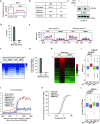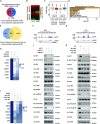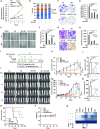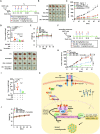Super-enhancer-controlled positive feedback loop BRD4/ERα-RET-ERα promotes ERα-positive breast cancer
- PMID: 36124682
- PMCID: PMC9561272
- DOI: 10.1093/nar/gkac778
Super-enhancer-controlled positive feedback loop BRD4/ERα-RET-ERα promotes ERα-positive breast cancer
Abstract
Estrogen and estrogen receptor alpha (ERα)-induced gene transcription is tightly associated with ERα-positive breast carcinogenesis. ERα-occupied enhancers, particularly super-enhancers, have been suggested to play a vital role in regulating such transcriptional events. However, the landscape of ERα-occupied super-enhancers (ERSEs) as well as key ERα-induced target genes associated with ERSEs remain to be fully characterized. Here, we defined the landscape of ERSEs in ERα-positive breast cancer cell lines, and demonstrated that bromodomain protein BRD4 is a master regulator of the transcriptional activation of ERSEs and cognate ERα target genes. RET, a member of the tyrosine protein kinase family of proteins, was identified to be a key ERα target gene of BRD4-regulated ERSEs, which, in turn, is vital for ERα-induced gene transcriptional activation and malignant phenotypes through activating the RAS/RAF/MEK2/ERK/p90RSK/ERα phosphorylation cascade. Combination therapy with BRD4 and RET inhibitors exhibited additive effects on suppressing ERα-positive breast cancer both in vitro and in vivo, comparable with that of standard endocrine therapy tamoxifen. Furthermore, combination therapy re-sensitized a tamoxifen-resistant ERα-positive breast cancer cell line to tamoxifen treatment. Taken together, our data uncovered the critical role of a super-enhancer-associated positive feedback loop constituting BRD4/ERα-RET-ERα in ERα-positive breast cancer, and suggested that targeting components in this loop would provide a new therapeutic avenue for treating ERα-positive breast cancer in the clinic.
© The Author(s) 2022. Published by Oxford University Press on behalf of Nucleic Acids Research.
Figures








Similar articles
-
Targeting the receptor tyrosine kinase RET sensitizes breast cancer cells to tamoxifen treatment and reveals a role for RET in endocrine resistance.Oncogene. 2010 Aug 19;29(33):4648-57. doi: 10.1038/onc.2010.209. Epub 2010 Jun 7. Oncogene. 2010. PMID: 20531297
-
The ERα-miR-575-p27 feedback loop regulates tamoxifen sensitivity in ER-positive Breast Cancer.Theranostics. 2020 Aug 29;10(23):10729-10742. doi: 10.7150/thno.46297. eCollection 2020. Theranostics. 2020. PMID: 32929377 Free PMC article.
-
Bromodomain protein BRD4 is required for estrogen receptor-dependent enhancer activation and gene transcription.Cell Rep. 2014 Jul 24;8(2):460-9. doi: 10.1016/j.celrep.2014.06.016. Epub 2014 Jul 10. Cell Rep. 2014. PMID: 25017071 Free PMC article.
-
Estrogen receptors in breast carcinogenesis and endocrine therapy.Mol Cell Endocrinol. 2015 Dec 15;418 Pt 3:240-4. doi: 10.1016/j.mce.2014.11.015. Epub 2014 Nov 26. Mol Cell Endocrinol. 2015. PMID: 25433206 Review.
-
RET in breast cancer: functional and therapeutic implications.Trends Mol Med. 2011 Mar;17(3):149-57. doi: 10.1016/j.molmed.2010.12.007. Epub 2011 Jan 19. Trends Mol Med. 2011. PMID: 21251878 Review.
Cited by
-
Super-enhancers and the super-enhancer reader BRD4: tumorigenic factors and therapeutic targets.Cell Death Discov. 2023 Dec 22;9(1):470. doi: 10.1038/s41420-023-01775-6. Cell Death Discov. 2023. PMID: 38135679 Free PMC article. Review.
-
A novel super-enhancer-related gene signature predicts prognosis and immune microenvironment for breast cancer.BMC Cancer. 2023 Aug 18;23(1):776. doi: 10.1186/s12885-023-11241-2. BMC Cancer. 2023. PMID: 37596527 Free PMC article. Clinical Trial.
-
The BET PROTAC inhibitor GNE-987 displays anti-tumor effects by targeting super-enhancers regulated gene in osteosarcoma.BMC Cancer. 2024 Aug 1;24(1):928. doi: 10.1186/s12885-024-12691-y. BMC Cancer. 2024. PMID: 39090568 Free PMC article.
-
Identifying Key Regulatory Genes in Drug Resistance Acquisition: Modeling Pseudotime Trajectories of Breast Cancer Single-Cell Transcriptome.Cancers (Basel). 2024 May 15;16(10):1884. doi: 10.3390/cancers16101884. Cancers (Basel). 2024. PMID: 38791962 Free PMC article.
-
A comprehensive overview of the relationship between RET gene and tumor occurrence.Front Oncol. 2023 Feb 14;13:1090757. doi: 10.3389/fonc.2023.1090757. eCollection 2023. Front Oncol. 2023. PMID: 36865807 Free PMC article. Review.
References
-
- Sung H., Ferlay J., Siegel R.L., Laversanne M., Soerjomataram I., Jemal A., Bray F.. Global cancer statistics 2020: GLOBOCAN estimates of incidence and mortality worldwide for 36 cancers in 185 countries. CA Cancer J. Clin. 2021; 71:209–249. - PubMed
-
- Burstein H.J. Systemic therapy for estrogen receptor-positive, HER2-negative breast cancer. Reply. N. Engl. J. Med. 2021; 384:1176–1177. - PubMed
Publication types
MeSH terms
Substances
LinkOut - more resources
Full Text Sources
Medical
Molecular Biology Databases
Research Materials
Miscellaneous

